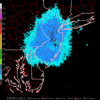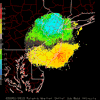Well look what happened right under my nose! I got all tied up this morning and took yesterday’s weather forecast over what was going on right outside my door. As soon as I stepped out I knew the cooler airmass had reached us last night…darnit! So, a migration event did occur last night, and it was pretty intense. Click on the thumbnails to view the base reflectivity (blue) and velocity (yellow/red) loops. The loops are from sunset last night through sunrise this morning. On the base reflectivity, you see the typical ‘blooming’ effect of birds entering the radar’s view, as the front passes from west to east. By viewing the velocity plot, you can also see how when the front passes, the wind direction turns around from the SW to W to NW. After seeing this, I immediately called Michael O’Brian down in Cape May and asked him how the morning flight was. He said that although warbler numbers were low (<100 individuals) they had a really good flight of Bobolinks, as well as many Eastern Kingbirds and Cedar Waxwings. I agreed with him when he said that tonight will likely be a better warbler flight, with lighter NW winds making for a better tailwind. What does this mean for birding? Well, as Sandra pointed out, it didn't mean much for Palmayra, probably because any birds behind the front had an easy passage overhead. This could hold true tomorrow, although there are many warblers 'piled up' to our north, so there's a good chance that some of them will land tomorrow morning. I'd bet that the coastal sites will be best in the morning, with the mountain ridges coming in at a close second. I'll post the radar tonight, before 11pm, and again tomorrow morning before 7am. Good birding!

